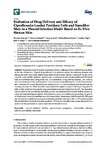Evaluation of Drug Delivery and Efficacy of Ciprofloxacin-Loaded Povidone Foils and Nanofiber Mats in a Wound-Infection Model Based on Ex Vivo Human Skin
Rancan, Fiorenza
Contardi, Marco
Jurisch, Jana
Blume-Peytavi, Ulrike
Vogt, Annika
Bayer, Ilker S.
Schaudinn, Christoph
Topical treatment of wound infections is often a challenge due to limited drug availability at the site of infection. Topical drug delivery is an attractive option for reducing systemic side effects, provided that a more selective and sustained local drug delivery is achieved. In this study, a poorly water-soluble antibiotic, ciprofloxacin, was loaded on polyvinylpyrrolidone (PVP)-based foils and nanofiber mats using acetic acid as a solubilizer. Drug delivery kinetics, local toxicity, and antimicrobial activity were tested on an ex vivo wound model based on full-thickness human skin. Wounds of 5 mm in diameter were created on 1.5 × 1.5 cm skin blocks and treated with the investigated materials. While nanofiber mats reached the highest amount of delivered drug after 6 h, foils rapidly achieved a maximum drug concentration and maintained it over 24 h. The treatment had no effect on the overall skin metabolic activity but influenced the wound healing process, as observed using histological analysis. Both delivery systems were efficient in preventing the growth of Pseudomonas aeruginosa biofilms in ex vivo human skin. Interestingly, foils loaded with 500 µg of ciprofloxacin accomplished the complete eradication of biofilm infections with 1 × 109 bacteria/wound. We conclude that antimicrobial-loaded resorbable PVP foils and nanofiber mats are promising delivery systems for the prevention or topical treatment of infected wounds.
Files in this item

